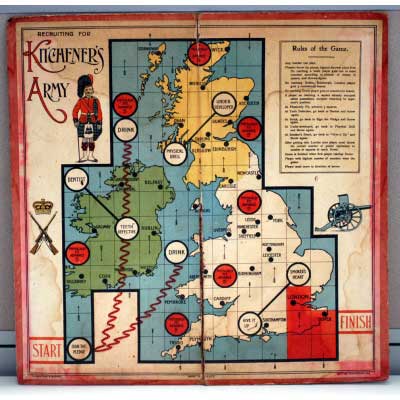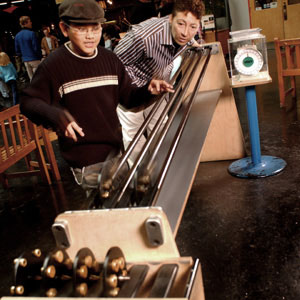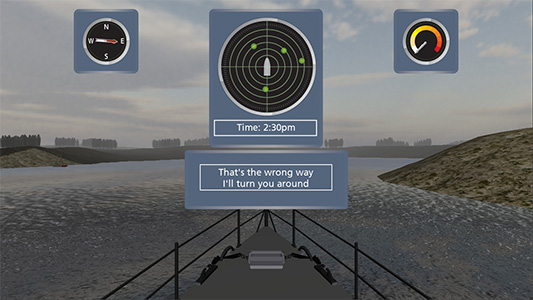Advice from me
Telling stories with games
“It’s a game; it’s not supposed to tell you anything”
An exhibition client once told me “It’s a game; it’s not supposed to tell you anything”. I disagreed but didn't say anything at the time. This essay looks at how games can be used to tell stories in a museum setting. But let's start with a more famous figure who would also saw how games could tell stoies; Lord Kitchener. Kitchener was in charge of recruitment for the British forces during the First World War and leant his name to the Kitcheners Army game shown below.

Image: Leeds Museums
The game plays a little like snakes and ladders and the aim is to avoid all the obstacles to being unfit for recruitment and achieve the (dubious) honour of reaching the front line in France. The Kitcheners Army game tells a story of both the social attitudes to recruitment (ie. “a good thing”) and the actual recruitment process itself.
Of, course, there are lots of games out there that don’t tell you very much but they don’t really belong in a museum. Having access to interesting and original stories is a key advantage that museums have over commercial games companies and it would be daft to ignore this.
So how can you use games to tell a museum story? Here’s an example from the splendidly named Company of Merchant Adventurers of York. They commissioned us to create a game which answered the question “What did the original Merchant Adventurers do?” Here’s the game, before you go any further spend a few minutes playing it.

Now you’ve played the game, try answering these questions
- What did the original Merchant Adventurers do?
- What sort of things did they trade in?
- What sort of places did they go to?
- What did they use the Merchant Adventurer’s Hall for?
There’s a lot more content in the game than that and the beauty of a good game is that people become really engrossed and many of them want to play several times.
What makes a game?
So what makes an activity into a game? This is a pretty key question. There are a lot of attempts to make games which don’t really understand the fundamental elements of what makes a game and so don’t really succeed. There are also lots of people writing about the nature of games but I didn’t really find the type of concise definition I was after. So this is what I came up with.
1. The player is put in a situation
2. The player makes a choice
3. The player receives feedback on that choice which may help with future choices
4. The situation may also change
5. Go to step 2 and make another choice.
This pretty much describes almost all games, from Space Invaders to Hangman and World of Warcraft. Even more usefully, it excludes many activities which aren’t really games. For example, playing the lottery doesn’t fit with this definition because the feedback you receive – winning or not winning – doesn’t help you make a better choice next time.
Here’s a screen from the Launchball game from the Science Museum. The feedback loop is particularly clear in this game.

The aim of the game is to get the ball to the exit. You arrange the elements and then press the "Test" button to see what happens. If you're not successful you have another go. Launchball is one of the most successful museum games ever, having been played by literally millions of people.
Just following this definition doesn’t guarantee that you’ll make a good game. There’s even more been written about how to design a good game but here’s a couple of fundamental principles:
1) Players need to feel that they have enough information to make an informed choice in step 2. In this screen from Extinct the “Smart plant tip” in the bottom left of the screen gives you hints as to what to do next.

2) Success or failure feedback needs to be gradual. Players shouldn’t be able to fail or succeed at the game through just one choice. In the Merchants game we considered the possibility that your ship could be wrecked or attacked by pirates. However, a random chance of losing everything would have made for a frustrating game so we didn’t include this.
Curiously this learning feedback loop has also been suggested by researchers looking into physical exhibits for museums and science centres. The Exploratorium in San Francisco ran the groundbreaking Applied Prolonged Engagement (APE) project which set out to construct mechanical exhibits which gave visitors gradual feedback on their choices which they could then use to inform their next move.

An APE exhibit. Visitors race two wheels down a track to find which goes faster. They can use the results of each race to form theories about what makes the fastest wheel – are heavier wheels faster? Or is it about the weight distribution?
Museum games are casual
Many museums have members of staff who watch and record how their visitors behave in the museum. One of the key findings of this research is that people will typically spend around three minutes using an interactive exhibit. This isn’t a precise figure; it’s an average and a pretty woolly one at that. The time can vary depending on the visitor, the exhibit and external factors – for example, people spend longer if you give them a seat. Having said all that, it’s still a useful guide. The other thing to bear in mind is that visitors don’t generally plan to play a game in a museum. They come to the gallery, if the exhibit looks appealing they approach it, if they can work out what to do straight away, they play it.
What this means is that many of the computer games you may have heard about or played aren’t good models for museum games because they assume a much higher level of commitment from players. Console games such as Gears of War 3 cost around £40 and typically take 40 hours to complete. Massive multiplayer online games such as World of Warcraft can be played for several years and usually require you to pay a monthly fee. Neither of these are a good model for museum games.
Instead we’re much better off looking at casual and arcade games. Casual games are designed to be immediately appealing with simple controls. They can often be played for short periods of time. You can find a wealth of casual games on the internet in portals such as Kongregate. There are also lot of casual games created for mobile phones and available from App stores such as Apples. It’s also worth looking in traditional arcades. The games here are also designed to be immediately appealing and have a physical side to them that is missing from internet and phone games.
Nobody dies today
Even if you haven’t played an arcade game for years, you probably know how they work. You put your money in, the game starts and if you make a mistake you lose a life. After losing three lives the game ends unless you put more money in for another go. If you’re good at the game you get to play for longer and at the end you get a high score.
This model of games playing was invented for arcades to maximise the amount of money they make. Players need to “die” to stop them playing the game all day without putting more money in. Being able to play for longer if they’re good at the game is an incentive to play (and pay) again.
For a museum game, things are different. Usually we have a scenario or amount of content we want players to work all the way through. Sending the player back to the start because they’ve died doesn’t help this aim. Similarly we don’t want to let successful players spend longer on the exhibit – other visitors probably want a go. This means that museum games shouldn’t normally have a possibility of dying or making it “to the next level”. However, it’s often a good idea to keep some kind of scoring system. Visitors have put some effort into playing the game and tend to want some feedback on how well they’ve done. In general they don’t find getting a low score too upsetting and much prefer it to vague “well done” feedback which doesn’t relate to how well they did.
3D or not 3D?

A screen from Lego Star Wars
Modern console games tend to feature immersive interactive 3D graphics and it’s easy to fall into the trap of thinking that 3D graphics are the logical upgrade for plain old 2D and must be better in every respect. This really isn’t the case. For casual games in particular, there a few areas where 3D is noticeably worse than 2D.
3D is more difficult to control
2D games only have 4 directions of movement, which makes it easy to control them with a joystick or touchscreen. 3D games potentially have 6 directions of movement and you often want the player to be able to turn and look in a different direction as well. PC games typically use a mouse and keyboard or a gamepad with two joysticks. Both of these approaches are too complex for a casual player so you need to come up with something simpler.

A gamepad from a PlayStation 3. Note the two small joysticks and eight buttons. This is far too complex for a casual museum game.
3D makes it more difficult to know what to do
In a 2D game, such as Pacman, you often have a top down view of the scene so you can see where things are and decide how to get to them. In a 3D game you usually have a first person view so you can only see in one direction and you can’t see through walls. This makes knowing which direction to go much more difficult.
So why use 3D at all?
So what’s the advantage of 3D games? Essentially it’s about atmosphere and immersion. 3D makes players feel that they’re really in the place, performing the actions. 3D games feel much more “real” and players are more likely to have an emotional reaction. If you want to talk about complex topics or abstract content, 2D is best, but if you want visitors to feel they’re in a particular place or situation then 3D wins hands down.

A 3D museum game - Sail a customs cutter and catch the bad guys.
How to make the best of 3D
Keep it simple
Visitors will have enough problems working the controls, working out where they are and what they need to do. Make the tasks they have to achieve very simple.
Give them help to go the right way
As we’ve mentioned it’s easy to get lost in a 3D environment. Rather than just letting visitors wander around, give them a clear goal and cues on what they need to do.
If they go the wrong way, put them back
If visitors go the wrong way in your 3D environment then you need to have a mechanism for putting them on the right track. Otherwise they won’t find what they’re looking for and usually just give up. Many of the best racing games will detect if you drive the wrong way down the track and automatically pick you up and turn you round. 3D museum games need something similar.

Game over
We're used to the idea that there's lots of different ways to tell a story; from a 500 page novel, to a soap opera or a funny story you tell in a pub. Similarly, there's also lots of different types of games, each with particular characteristics including, difficulty, length and the commitment of the players. There isn't one "right" way to use a game to tell a story but there are lots of different issues to consider. Ideally the story and the content should be the core of the game rather than feeling "tacked on". The design of the game should reflect the who's playing them and the environment they're in. Most important of all, a game should be fun.Further reading
Fostering Active Prolonged Engagement: The Art of Creating APE Exhibits, Humphrey and Gutwill
The Exploratorium science centre in San Francisco had an extensive project to create mechanical exhibits which use the same feedback loop principles as my game definition. The project also has a website, but there's a lot more detail in the book.
How
do visitors use computer exhibits? Findings from 5 grueling years of watching
visitors getting it wrong
Ben Gammon spent many years as Head of Visitor Studies at the Science Museum.
Here's the benefit of his experience working with technologies from light
beams to fingerprint scanners.
Show me
Archive of online games from UK museums and galleries.
Gamasutra
Gamasutra is a games industry website. Doesn't usually concern itself with museum type educational games but has a wide range of articles on all aspects of game development. The best are the postmortems of game projects which tell you just what went wrong (and right).
Kongregate
Kongregate is a web games portal which contains thousands of games. Many of these fall into the casual category and are good sources of inspiration for museum games.
© Joe Cutting 2010. You are welcome to
use this document for your own purposes but you must retain this acknowledgment.
You may not sell all or any part of this document or use it for financial
gain.

 Back to top
Back to top